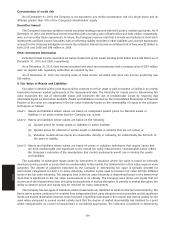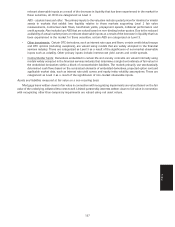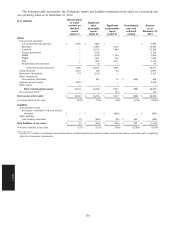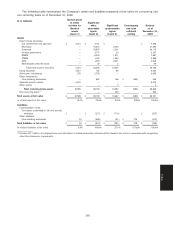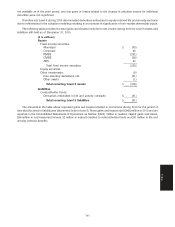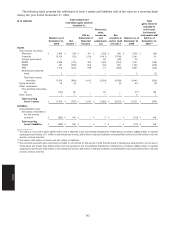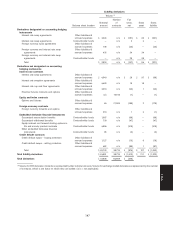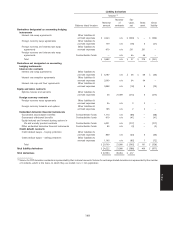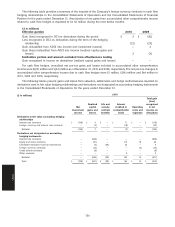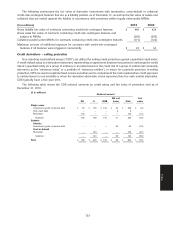Allstate 2011 Annual Report Download - page 224
Download and view the complete annual report
Please find page 224 of the 2011 Allstate annual report below. You can navigate through the pages in the report by either clicking on the pages listed below, or by using the keyword search tool below to find specific information within the annual report.
collateral. The fair value of limited partnership interests accounted for on the cost basis is determined using reported
net asset values of the underlying funds. The fair value of bank loans, which are reported in other investments on the
Consolidated Statements of Financial Position, are based on broker quotes from brokers familiar with the loans and
current market conditions.
Financial liabilities
December 31, 2010 December 31, 2009
($ in millions)
Carrying Fair Carrying Fair
value value value value
Contractholder funds on investment contracts $ 36,163 $ 35,194 $ 40,943 $ 39,328
Long-term debt 5,908 6,325 5,910 6,016
Liability for collateral 484 484 658 658
The fair value of contractholder funds on investment contracts is based on the terms of the underlying contracts
utilizing prevailing market rates for similar contracts adjusted for the Company’s own credit risk. Deferred annuities
included in contractholder funds are valued using discounted cash flow models which incorporate market value
margins, which are based on the cost of holding economic capital, and the Company’s own credit risk. Immediate
annuities without life contingencies and fixed rate funding agreements are valued at the present value of future benefits
using market implied interest rates which include the Company’s own credit risk.
The fair value of long-term debt is based on market observable data (such as the fair value of the debt when traded
as an asset) or, in certain cases, is determined using discounted cash flow calculations based on current interest rates
for instruments with comparable terms and considers the Company’s own credit risk. The liability for collateral is valued
at carrying value due to its short-term nature.
6. Derivative Financial Instruments and Off-balance-sheet Financial Instruments
The Company primarily uses derivatives for risk management, to partially mitigate potential adverse impacts from
changes in risk-free interest rates, negative equity market valuations and increases in credit spreads, and asset
replication. In addition, the Company has derivatives embedded in non-derivative host contracts that are required to be
separated from the host contracts and accounted for at fair value. With the exception of non-hedge derivatives used for
asset replication and non-hedge embedded derivatives, all of the Company’s derivatives are evaluated for their ongoing
effectiveness as either accounting hedge or non-hedge derivative financial instruments on at least a quarterly basis. The
Company does not use derivatives for trading purposes. Non-hedge accounting is generally used for ‘‘portfolio’’ level
hedging strategies where the terms of the individual hedged items do not meet the strict homogeneity requirements to
permit the application of hedge accounting.
Property-Liability uses interest rate swaption contracts and exchange traded options on interest rate futures to
offset potential declining fixed income market values resulting from potential rising interest rates. Property-Liability also
uses interest rate swaps to mitigate municipal bond interest rate risk within the municipal bond portfolio. Exchange
traded equity put options are utilized by Property-Liability for overall equity portfolio protection from significant declines
in equity market values below a targeted level. Equity index futures are used by Property-Liability to offset valuation
losses in the equity portfolio during periods of declining equity market values. Credit default swaps are typically used to
mitigate the credit risk within the Property-Liability fixed income portfolio.
Portfolio duration management is a risk management strategy that is principally employed by Property-Liability
wherein, depending on the current portfolio duration relative to a designated target and the expectations of future
interest rate movements, financial futures and interest rate swaps are utilized to change the duration of the portfolio in
order to offset the economic effect that interest rates would otherwise have on the fair value of its fixed income
securities.
Property-Liability uses futures to hedge the market risk related to deferred compensation liability contracts and
forward contracts to hedge foreign currency risk associated with holding foreign currency denominated investments
and foreign operations.
Allstate Financial uses foreign currency swaps primarily to reduce the foreign currency risk associated with issuing
foreign currency denominated funding agreements and holding foreign currency denominated investments. Credit
default swaps are also typically used to mitigate the credit risk within the Allstate Financial fixed income portfolio.
144
Notes


